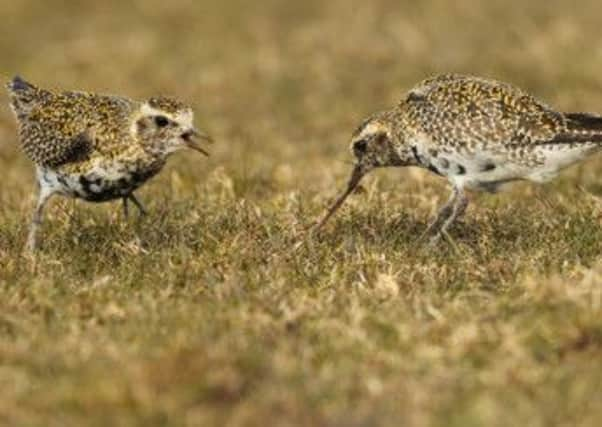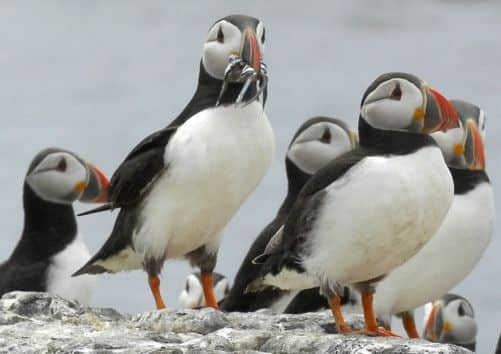Icy blast takes toll as birds battle to find food


Spring sprung so late this year that it has left the landscape looking brown – burnt by wind and frost – and the wildlife in a sorry state.
The insects are thankfully now finally emerging but the early summer migrant birds had nothing to eat when they arrived at the beginning of this month exhausted by their long trans-continental flights.
Advertisement
Hide AdAdvertisement
Hide AdMeanwhile, those birds that had migrated here for the winter, such as waxwings, fieldfares, woodcock and short-eared owls, have been stranded up until now, unable to make it back across the North Sea to Scandinavia due to a bitterly cold easterly wind that has persisted for much of the year.


Blasting here straight from the Baltic, these powerful winds have devastated much of our birdlife. They brought about the worst puffin “wreck” – the death of a large number of seabirds in a single incident – in almost 50 years, according to the RSPB.
Thought to have been unable to feed in the wind-whipped seas, two hundred puffins were washed up either dead or dying on Yorkshire’s beaches at the end of March. A staggering 10 per cent of the Bempton population is thought to have been lost. Birds like guillemots and razorbills were also affected.
It happened when the puffins were at their most vulnerable. They had only just moved closer to their breeding grounds and in the process of moulting out their feathers ready for the breeding season. This process leaves them virtually flightless. It is thought that the turbulent waters affected their main food source – sand eels – which swam down to deeper waters. Puffins are shallow divers and were unable to hunt down to these depths, nor were they able to fly to new feeding grounds because of the state of their feathers.
Advertisement
Hide AdAdvertisement
Hide AdPuffins are really hardy birds and the loss only goes to show just how harsh the weather was.
Over Easter I decided to try to escape the perishing easterly winds and headed west to North Wales. But it was no warmer there.
The mountains were white with deep snow and looked spectacular, if a little out of season. I headed out to Anglesey to look for some potential painting subjects to photograph.
Against the backdrop of the sea I saw a huge flock, made up of hundreds of golden plovers, circling a field.
Advertisement
Hide AdAdvertisement
Hide AdI was in luck as I knew the farmer whose field they had chosen so I was able to ask permission put up a hide in the corner of the field.
I set it up the very next day. It was a “balmy” 4C with a biting northerly wind and the only suitable place for my hide was a freezing bog. There was nothing for it but to stand in three inches of cold water for the day. Still, it would turn out to be worth it.
By the time I had finished building the hide and had settled down in it, the plovers had moved to the far side of the field. Thankfully they slowly moved my way, steadily searching the ground for worms. They hunted like thrushes do, breaking into quick, short runs, then pausing, their heads cocked to one side, as they waited and listened for worms underground.
I was surprised by how many they pulled up. As I watched them carefully tease them out of the ground, I noticed the ewes and lambs that were in the field had no new grass to eat. This really was an unusual spring.
Advertisement
Hide AdAdvertisement
Hide AdThe plovers were just coming into range to photograph when a pair of buzzards circled a nearby wood and suddenly all the plovers clamped down flat to the ground. It was as if they were synchronised. I was amazed by just how camouflaged they were against the browned grasses.
Next a raven came over the wall and landed in the field. The plovers burst into flight and formed a tight pack as they flew over the shore, moving in formation.
In actual fact, buzzards and ravens were the least of their worries. Here peregrines are the main threat as they are most capable at catching these fast-moving waders.
As the plovers circled overhead, making their beautiful, flutey, whistling calls, it looked as if they were going to land a few times.
Advertisement
Hide AdAdvertisement
Hide AdBut they were put off by the raven strutting around the field. Then they flew right over my head and landed in the field behind me. Typical!
All was not lost as there was plenty of other bird life to keep me occupied. There was a snipe on the edge of the bog, probing for worms, and teal in one corner of the field making their whistling “creelycc” call.
I also saw a pair of pied wagtails looking for insect life and there were more than half a dozen meadow pipits all around me.
And then a wheatear – a summer migrant which will have travelled all the way from Africa – waiting for the mountains to thaw out, like the plovers and the meadow pipits. It was fascinating to watch all these birds coping with the harsh spring weather.
Advertisement
Hide AdAdvertisement
Hide AdI love being in a hide. It is the closest you can get to being invisible. Nevertheless I was starting to get cold. Despite plenty of layers,the relentless wind was getting to me. I was just wondering whether the plovers would come back when I saw the buzzards in the air again. They were displaying their skydiving skills, trying to impress one another.
Then the plovers were airborne again and had nearly disappeared when they turned back my way. Hugging the shore line, they rushed overhead. I thought they were going to land on the field behind me again but as I looked out of the back of my hide I saw their wings glistening in the sun as they turned and landed all around me. I had been waiting for three hours for this moment and it was worth every minute. They spread out over the field – some just seven metres away from me.
As I watched them delicately tease worms out of the ground, I noticed how they stood up to other birds like starlings which would try to flush away the plovers with a “gang” mentality.
The pattern continued with the birds taking flight or squatting to the ground to avoid danger and then coming close enough to me to photograph. I left the hide at 5.30pm – very cold but satisfied with my photographs.
Advertisement
Hide AdAdvertisement
Hide AdI had enough ideas to compose a beautiful painting. I just hoped the birds had enough worms to survive this difficult spring.
Golden plovers’ shining example
Golden Plovers are striking birds, with gold-speckled wings and a pale underbelly which gives them a beautiful flickering effect when they twist and turn in flight.
These birds have usually flown up to the mountains to nest at this time of year, but they were clearly waiting on the lower lands for the snows to melt.
They were feeding on the estuary at low tide and then moving up to the nearby fields at high tide.